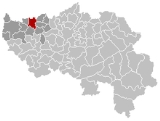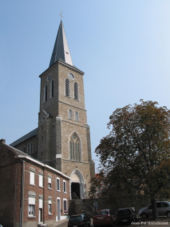
Waremme
Encyclopedia
Waremme is a Walloon municipality located in the province of Liège
, in Belgium
. The city is located on the River Geer
, in the loessic Hesbaye
region. The economy is based on the cultivation of cereals and sugar beet, and on the food industry.
The municipality of Waremme includes the following villages: Bettincourt
, Bleret, Bovenistier, Grand-Axhe, Lantermange, and Oleye .
and Bronze Age
settlements. The main Roman
road linking Bavai to Cologne
passed right through the territory. Tumuli and Roman villa
s were found nearby.
The medieval hamlet of Woromia was cited for the first time in 965. On February 5, 1078, Woromia was ceded to the Prince-Bishopric of Liège, together with its castle, five mills, and six breweries. By 1215, with its 815 inhabitants, it had grown to town size. Its frontier position near the Duchy of Brabant
, however, attracted several raids from the duke, causing it to be burnt to the ground and rebuilt at least a couple of times. In the 14th century, the town built a market place and a hospital, slowly becoming an important regional center, where coins were issued and important meetings held.
During his conquest of the Prince-Bishopric of Liège, Charles the Bold
burnt the city once more in 1468. In the 16th century, the town became one of the 21 bonnes villes (main cities) of the prince-bishopric. In 1748, a quarter of the city was again destroyed by fire, this time accidentally. In 1792, the French Revolution
ary troops entered the city and closed the convents. Three years later, the Prince-Bishopric of Liège was dissolved and the city became French
.
The 19th century was prosperous, thanks to the advent of the railways linking Mechelen
to Ans
, and the construction of two sugar refineries and several schools. World War I
did not bring any destruction to the city, except for that of the old surrounding walls. World War II
, however, was a lot worse as half of the city was destroyed by air raids, only days before Liberation Day
. The city then counted about 5,000 inhabitants.

with:
Liège (province)
Liège is the easternmost province of Belgium and belongs to the Walloon Region. It is an area of French and German ethnicity. It borders on the Netherlands, Germany, Luxembourg, and in Belgium the provinces of Luxembourg, Namur, Walloon Brabant , and those of Flemish Brabant and Limburg . Its...
, in Belgium
Belgium
Belgium , officially the Kingdom of Belgium, is a federal state in Western Europe. It is a founding member of the European Union and hosts the EU's headquarters, and those of several other major international organisations such as NATO.Belgium is also a member of, or affiliated to, many...
. The city is located on the River Geer
Jeker
The Jeker is a river in Belgium and the Netherlands. It is a left tributary to the river Meuse. The source of the Jeker is near the village Geer in the Belgian province Liège. Most of its course is in Belgium , except the final approx. 5 km in the Netherlands...
, in the loessic Hesbaye
Hesbaye
Hesbaye or Haspengouw , is a region spanning the south of the Belgian province of Limburg, the east of the Belgian provinces of Flemish Brabant and Walloon Brabant, and the northwestern part of the province of Liège.The Limburgish portion contains the cities of Tongeren, Sint-Truiden, Bilzen and...
region. The economy is based on the cultivation of cereals and sugar beet, and on the food industry.
The municipality of Waremme includes the following villages: Bettincourt
Bettincourt
Bettincourt is part of the Belgian municipality of Waremme, located in Wallonia in the Province of Liège....
, Bleret, Bovenistier, Grand-Axhe, Lantermange, and Oleye .
History
Several findings were unearthed near Waremme containing remnants of NeolithicNeolithic
The Neolithic Age, Era, or Period, or New Stone Age, was a period in the development of human technology, beginning about 9500 BC in some parts of the Middle East, and later in other parts of the world. It is traditionally considered as the last part of the Stone Age...
and Bronze Age
Bronze Age
The Bronze Age is a period characterized by the use of copper and its alloy bronze as the chief hard materials in the manufacture of some implements and weapons. Chronologically, it stands between the Stone Age and Iron Age...
settlements. The main Roman
Ancient Rome
Ancient Rome was a thriving civilization that grew on the Italian Peninsula as early as the 8th century BC. Located along the Mediterranean Sea and centered on the city of Rome, it expanded to one of the largest empires in the ancient world....
road linking Bavai to Cologne
Cologne
Cologne is Germany's fourth-largest city , and is the largest city both in the Germany Federal State of North Rhine-Westphalia and within the Rhine-Ruhr Metropolitan Area, one of the major European metropolitan areas with more than ten million inhabitants.Cologne is located on both sides of the...
passed right through the territory. Tumuli and Roman villa
Villa
A villa was originally an ancient Roman upper-class country house. Since its origins in the Roman villa, the idea and function of a villa have evolved considerably. After the fall of the Roman Republic, villas became small farming compounds, which were increasingly fortified in Late Antiquity,...
s were found nearby.
The medieval hamlet of Woromia was cited for the first time in 965. On February 5, 1078, Woromia was ceded to the Prince-Bishopric of Liège, together with its castle, five mills, and six breweries. By 1215, with its 815 inhabitants, it had grown to town size. Its frontier position near the Duchy of Brabant
Duchy of Brabant
The Duchy of Brabant was a historical region in the Low Countries. Its territory consisted essentially of the three modern-day Belgian provinces of Flemish Brabant, Walloon Brabant and Antwerp, the Brussels-Capital Region and most of the present-day Dutch province of North Brabant.The Flag of...
, however, attracted several raids from the duke, causing it to be burnt to the ground and rebuilt at least a couple of times. In the 14th century, the town built a market place and a hospital, slowly becoming an important regional center, where coins were issued and important meetings held.
During his conquest of the Prince-Bishopric of Liège, Charles the Bold
Charles I, Duke of Burgundy
Charles the Bold , baptised Charles Martin, was Duke of Burgundy from 1467 to 1477...
burnt the city once more in 1468. In the 16th century, the town became one of the 21 bonnes villes (main cities) of the prince-bishopric. In 1748, a quarter of the city was again destroyed by fire, this time accidentally. In 1792, the French Revolution
French Revolution
The French Revolution , sometimes distinguished as the 'Great French Revolution' , was a period of radical social and political upheaval in France and Europe. The absolute monarchy that had ruled France for centuries collapsed in three years...
ary troops entered the city and closed the convents. Three years later, the Prince-Bishopric of Liège was dissolved and the city became French
France
The French Republic , The French Republic , The French Republic , (commonly known as France , is a unitary semi-presidential republic in Western Europe with several overseas territories and islands located on other continents and in the Indian, Pacific, and Atlantic oceans. Metropolitan France...
.
The 19th century was prosperous, thanks to the advent of the railways linking Mechelen
Mechelen
Mechelen Footnote: Mechelen became known in English as 'Mechlin' from which the adjective 'Mechlinian' is derived...
to Ans
Ans
Ans is a small Belgian municipality located in the Walloon province of Liège. On January 1, 2006 Ans had a total population of 27,322. The total area is 23.35 km² which gives a population density of 1,170 inhabitants per km²...
, and the construction of two sugar refineries and several schools. World War I
World War I
World War I , which was predominantly called the World War or the Great War from its occurrence until 1939, and the First World War or World War I thereafter, was a major war centred in Europe that began on 28 July 1914 and lasted until 11 November 1918...
did not bring any destruction to the city, except for that of the old surrounding walls. World War II
World War II
World War II, or the Second World War , was a global conflict lasting from 1939 to 1945, involving most of the world's nations—including all of the great powers—eventually forming two opposing military alliances: the Allies and the Axis...
, however, was a lot worse as half of the city was destroyed by air raids, only days before Liberation Day
Liberation Day
Liberation Day is a day, often a public holiday, that marks the liberation of a place, similar to an independence day. Liberation marks the date of either a revolution, as in Cuba, or the end of an occupation by another state, thereby differing from independence in the meaning of secession from...
. The city then counted about 5,000 inhabitants.
Sights

- The charming City Hall dates from 1900.
- The town’s main church dates from 1881 and houses 14th-century baptismal fonts.
- A natural reserve can also be found on the territory of Waremme.
Twin towns — Sister cities
Waremme is twinnedTown twinning
Twin towns and sister cities are two of many terms used to describe the cooperative agreements between towns, cities, and even counties in geographically and politically distinct areas to promote cultural and commercial ties.- Terminology :...
with:
- SkopjeSkopjeSkopje is the capital and largest city of the Republic of Macedonia with about a third of the total population. It is the country's political, cultural, economic, and academic centre...
: GérardmerGérardmerGérardmer is a commune in the Vosges department in Lorraine in northeastern France.-Culture:The Fantastic'Arts festival of horror and fantastic film has been held in Gérardmer each year since 1994.-External links:...
: GallinaroGallinaroGallinaro is a comune in the Province of Frosinone in the Italian region Lazio, located about 110 km east of Rome and about 40 km east of Frosinone...
External links
- Official web site (in FrenchFrench languageFrench is a Romance language spoken as a first language in France, the Romandy region in Switzerland, Wallonia and Brussels in Belgium, Monaco, the regions of Quebec and Acadia in Canada, and by various communities elsewhere. Second-language speakers of French are distributed throughout many parts...
)

